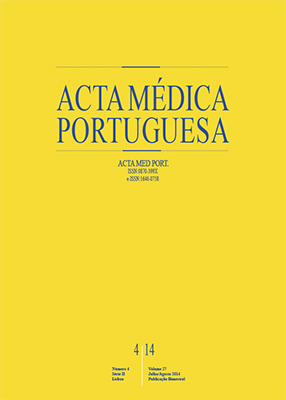Secondary Hypothyroidism after Cervical Irradiation: Systematic Evaluation of Thyroid Function in Follow-up
DOI:
https://doi.org/10.20344/amp.5109Abstract
Introduction: Sometimes Thyroid dysfunction is an underestimated consequence of radiation exposure. The underlying mechanism is not clearly understood, but it is likely to be multifactorial. As so, the specific risk factors associated with the development of secondary radiotherapy hypothyroidism remain undefined. The direct irradiation of the thyroid gland may result more frequently in hypothyroidism. This is an irreversible condition, requiring lifelong treatment and monitoring.Objectives: To evaluate the incidence of hypothyroidism in patients with head and neck cancer who underwent neck irradiation on an intensive or adjuvant basis and determine whether it is justifiable to integrate the monitoring of parameters for evaluation of thyroid function (TSH, free fraction T3 e free fraction T4 ) in this patient group on the Institutional follow up protocol.
Material and Methods: This is an observational, retrospective descriptive study, which comprises a group of 376 patients with head and neck cancer undergoing radiotherapy, on adjuvant or intensive basis, between the years 2007 and 2012, at Portuguese Institute of Oncology of Coimbra, E.P.E. 145 patients met all the inclusion criteria. Standardized rating scales for the definition of hypothyroidism have been used - LENT-SOMA scales (Late Effects Normal Tissues Subjective Objective Management Analysis). Grade 1 or higher was considered as a complication hypothyroidism.
Results: The analysis of a cohort of 145 patients was carried out. The most frequent tumor site was the larynx (26.9%). Thirty-two patients received adjuvant radiotherapy and 113 were treated with intensive schemes. The most used radiotherapy technique was intensity modulated (IMRT), performed in 86.2% patients. The overall incidence rate of hypothyroidism at 12 months was 18.6%. The diagnosis for hypothyroidism was done between 9 and 12 months after treatment radiotherapy in 51.9% of the patients with this
complication.
Discussion: An analysis of the published literature, hypothyroidism is the most common thyroid complication after irradiation and affects a large percentage of patients undergoing cervical radiotherapy with curative intent. It has been shown that the risk of hypothyroidism increases with time after exposure, but the highest incidence appears to be in the first two years after treatment. From our analysis we obtained at 12 months, a rate of incidence of hypothyroidism of 18.6% (16.55% grade 1 and grade 2, 2.1%).
Conclusions: This study found an incidence of hypothyroidism corresponding to the lowest values reported in other published studies. The short duration of follow-up considered in this analysis, may justify these results. With these results and their correlation with the available literature, the authors consider justified and recommend the inclusion of the systematic evaluation of thyroid function in the follow-up protocol of these patients.
Keywords: Head and Neck Neoplasms; Radiotherapy; Hypothyroidism; Follow-up Studies.
Downloads
Downloads
Published
How to Cite
Issue
Section
License
All the articles published in the AMP are open access and comply with the requirements of funding agencies or academic institutions. The AMP is governed by the terms of the Creative Commons ‘Attribution – Non-Commercial Use - (CC-BY-NC)’ license, regarding the use by third parties.
It is the author’s responsibility to obtain approval for the reproduction of figures, tables, etc. from other publications.
Upon acceptance of an article for publication, the authors will be asked to complete the ICMJE “Copyright Liability and Copyright Sharing Statement “(http://www.actamedicaportuguesa.com/info/AMP-NormasPublicacao.pdf) and the “Declaration of Potential Conflicts of Interest” (http:// www.icmje.org/conflicts-of-interest). An e-mail will be sent to the corresponding author to acknowledge receipt of the manuscript.
After publication, the authors are authorised to make their articles available in repositories of their institutions of origin, as long as they always mention where they were published and according to the Creative Commons license.









